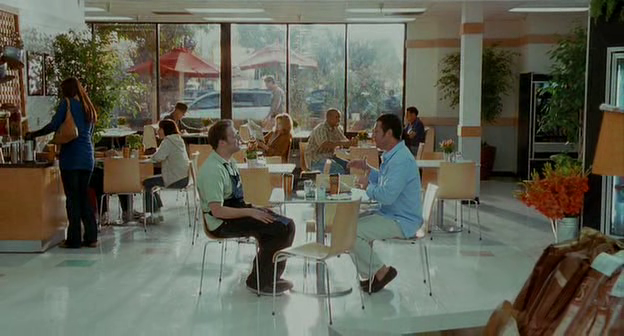I've read my fair share of movie reviews and I've written a few as well. One word that I've come across often in these reviews is "unbalanced"; it is usually negative and accompanied by a suggestion that it feels like two different movies instead of one. Most of the time this lack of balance is caused by bad writing, but sometimes it's done intentionally, or at least occurs out of a happy accident. It can still be off putting if you're not in on it, but if you can see why the story tellers would want to tell two different stories it can give a new appreciation for the movie or TV show. For instance:
Funny People is about Adam Sandler playing a comedy legend turned hack and total jerk, so basically he's playing himself. Judd Apatow directed the movie because he's best equipped to keep Sandler from realizing it and getting his feelings hurt. There are certain scenes where you can almost hear Apatow saying "What? No! You're nothing like this George Simmons character. Hey, you should make out with my wife some more. You wanna do that?" The main difference between Adam and George is that George has cancer. The first scene of the movie is George receiving his diagnosis. Soon after that the focus shifts to the struggling young comic Ira, played by Seth Rogen. George takes Ira under his wing and hires him to write some jokes and help him with other miscellanea. We still see plenty of George as he struggles with his disease, but mostly this movie is about Ira's complicated relationship with his idol and his personal problems with his roommates and his crush on the girl down the hall. George even takes an interest in Ira's life and helps him out. Then George's cancer goes into remission. Now that his life isn't in immediate danger George reverts to his selfish ways. The movie is now about George reconnecting with his old flame Laura, played by Leslie Mann, who is married with two children. George and Ira leave L.A. altogether to visit with Laura and her family in the suburbs. George's shameless attempts to rekindle his relationship with Laura at the risk of breaking up her family ultimately drives George and Ira apart. When the two return to L.A. Ira goes back to work at a sub shop and George continues his lonely and spiteful life. Finally George visits Ira at the sub shop to give him some jokes George wrote for him. It is George's first true act of selflessness in the film, and the final shot is George and Ira sitting together on equal footing.

It seems that with all the anticipation for
Agents of S.H.I.E.L.D. last year many people forgot a very important of rule of television: If there's a Whedon involved the show will probably need a season, give or take, before it finds its footing. (The obvious exception being
Firefly, which foresaw its untimely demise and went out in a blaze of glory.) In the case of
Agents of S.H.I.E.L.D. the first fifteen or sixteen episodes were slow and at times boring because it wasn't the show it was always meant to be yet. What seemed like a typical "monster of the week" paranormal investigation series was actually just showrunners Maurissa Tancharoen and Jed Whedon biding time until the events of
Captain America: The Winter Soldier and
AoS episode "Turn Turn Turn" could reveal that S.H.I.E.L.D. had been infiltrated by evil Hydra agents for years, including a trusted member of the team. In the span of one episode and a movie
AoS stopped being an
X-Files clone and became a 60's spy vs. spy throwback action comedy and then some. Everything before that was just world and character building to raise the stakes for the surprise unmasking. Perhaps those early episodes could have been handled better, but they can be forgiven considering the excellence of the last six episodes.
Stanley Kubrick is largely agreed to be one of the greatest directors of all time. There are plenty of people far more qualified than I to wax on about the brilliance of films like
2001: A Space Odyssey, A Clockwork Orange, The Shining, etc. Instead this will be about one of his more mildly received movies. The first half of
Full Metal Jacket is iconic, particularly thanks to the performance of R. Lee Ermey's as drill instructor Sergeant Hartman. It's also visually stunning, which is par for Kubrick, who is famous for his use of symmetry and other patterns. By making a movie about Marine Corps boot camp Kubrick finally got to live his dream of making patterns out of people. Eventually, Hartman's archaic brand of discipline drives Private Lawrence (Vincent D'Onofrio) too far. He kills the Sergeant then himself as Matthew Modine's Private Davis watches. Immediately after that scene there's a jump in time and this movie follows Davis, who is a sergeant and combat correspondent in Vietnam. The rest of the movie is almost unrecognizable from the first half. The order and discipline of boot camp and Kubrick's signature patterns have vanished, to be replaced entirely by the chaos of war.
This
becomes this.
The stark contrast of the two halves of the movie has been widely criticized even though dichotomy is a major theme, especially in the second half. There is quite a bit of discussion in the film about the disparity between the words "Born to Kill" on Davis' helmet and the peace medallion pinned on his uniform. Davis even explicitly explains that it is a shout out to Jung's philosophy of the duality of man. Regardless, the first half of
Full Metal Jacket is far more famous than the second, perhaps because most people check out before they get to the nitty gritty Jungian philosophy part of the war movie.



